SONS OF DEWITT COLONY TEXAS
The Z and ZA above are cattle brands Z-1 and Z-2 registered to Adam Zumwalt in Gonzales 5 Jan 1830 and 3 May 1834, respectively. One was probably assigned for "Black" Adam Zumwalt Jr. described here and the other for his hotelier and merchant cousin "Red" Adam Zumwalt Sr. The Zumwalts-Alsace-Lorraine, Pennsylvania, Virginia, Kentucky, Missouri. "Black" Adam Zumwalt was born 18 May 1795 in FayetteCo, Kentucky, the fourth child of Andrew Charles Zumwalt Jr. (abt 1758-abt 1823) and Margaret Baldridge (birthdate unknown, d. abt 1844, married abt 1792). The tags "Black," "Jr." and "2nd" distinguish "Black" Adam Zumwalt Jr. (or 2nd) from the numerous Adam’s in the Zumwalt family including his older prominent DeWitt Colony cousin who is likewise distinguished by "Red" Adam Zumwalt Sr. Neither are sons of an Adam thus it is believed the two were assigned the tags by either themselves or record keepers and historians to distinguish them. Adam Zumwalt's father, Andrew Zumwalt Jr., was the son of Alsatian immigrant Johann Wilhelm Andres Zumwalt who landed in Baltimore, MD in 1737, resided and helped develop YorkCo, PA. After the death of William Penn, the family moved to Georgetown on the Potomoc River and then to ShenandoahCo, VA. His sons migrated to BourbonCo, KY where "Black" Adam Zumwalt was born. Andrew Zumwalt Jr. and family moved with his brothers Adam, Andrew, Christopher, John and Jacob from BourbonCo, KY along with Daniel Boone between 1796-1798 where they became citizens of Spain and received grants of land from the Spanish government in the St. Charles District of the Louisiana District of the Indiana Territory. Adam met and married Jane Strain Kent (first name listed as Mary or Martha in various records), oldest daughter of Isaac and Lucy Hopkins Kent, in St. CharlesCo, MO in 1814. Jane Strain Kent was born 25 January 1801 in AdairCo, KY and was the half-sister of Alamo defender and member of the Gonzales Alamo Relief force, Andrew Kent, who married "Black" Adam Zumwalt’s cousin Elizabeth Zumwalt (daughter of Jacob Zumwalt). An entry in the family bible of Gabriel and Celia Davis Zumwalt, found recently (year 2000) in an attic in Gonzales, confirms the marriage and birth dates of Adam and Jane S. Kent Zumwalt.
Arrival in the DeWitt Colony Texas from Missouri. Adam and Jane Strain Kent Zumwalt and family arrived in the DeWitt Colony in the same period as the five related extended families of Burket, Kent and Zumwalt between 1829-1830. It is unclear exactly how they arrived, whether by land or sea or in groups or individual families. Land grant documents state they arrived 22 May 1830 although these dates are not reliable as precise dates. If the birthdate of son Noah/Noel of 29 Dec 1829 is correct, than it is likely that the family came to Texas in the spring or summer of 1830. The family which arrived consisted of seven Missouri born children, five of whom were male.
The children of Capt. Adam Zumwalt and Mary Jane Strain Kent James | Andrew | Thomas | Isaac | Louisa | Lucinda | Noah | Mary | Gabriel | William | Claude | Jane | Nancy Some records suggest a son Claude b. 5 Feb 1840, d. 1840, who may have been a twin of Jane who also died young. Various records also suggest a son Jesse and Noah/Noel who died young in MO and a son William b. 1843. There is little information on son James or John C., some records also suggest he died young in MO, however, the sons listed below, born in MO, fit with Adam Zumwalt's five sons declared on his application for land title. James/John C. (10 Dec 1815 MO-1868)
Veteran of the Battle of San Jacinto
m. (2) Elizabeth Ellen Dempsey Hahn 4
Jul 1877 GonzalesCo, TX
Texas Ranger and Indian Fighter
Thomas Bowen Zumwalt Sr. and family, along with brother Isaac Zumwalt, remained in the area around Gonzales and Lavaca counties for some time after their father Adam moved to FayetteCo. Thomas Bowen Sr. moved from the DeWitt Colony area of Texas to New Mexico around 1885. He was counted in the 1885 census of LincolnCo, New Mexico, living near Artesia. In his book Sand in My Craw, stories of citizens of the "Free State of Lavaca," author Judge Paul Boethel relates:
Survivor of the Mier Expedition Isaac Kent
(11 Feb 1822 Lexington, LafayetteCo, MO-29 Dec 1868 GonzalesCo, TX) Louisa M. (7 Sep 1824 MO-1906)
m. (1) John Crawford (d. 1847) 25 Jan 1847 LavacaCo, TX
m. (3) Travis Daniel Atkinson
11 Feb 1856 FayetteCo, TX m. (4) G.W. Kennedy (d. 21 Dec 1888, BlancoCo, TX) 4 Jun 1867 1850 Census GonzalesCo, Peach Creek District: Love, Allen, 50, m, $125, Va.; Love, Lucinda, 23, f, Mo; Love, James, 17, m, Ala; Love, Joseph, 14, m, Ala.
Noah/Noel (4 Dec 1829 MO-1845)
Mary Elizabeth Gabriel
Elinor Jane (b. 2 May 1840 TX; died young) Nancy Ann (b. 24 Jun 1842 GonzalesCo, TX) "Black" Adam Zumwalt received title to a league, 24/25 sitio, of land on 8 May 1832 which was described as "on the watershed of Tejocotes Creek about 22 miles from the town of Gonzales." [Tejocote is a small yellow fruit, Pomum saxeum, similar to the hawthorn berry. The word came from Aztec texocotl meaning wild acid and hard fruit. Diarists on the Alarcon Expedition mentioned tejocotes, medlar and plum trees among the thick brush in Texas. Medlar was similar to crab apples and common in European Spain] Two branches of the northeast part of Peach Creek runs through the league in a north-south and north direction. Currently the league is split down the middle by the current Gonzales-Fayette County line running from the northwest to the southeast corner. The property is almost exactly halfway between the Lavaca County and the Caldwell-Bastrop County lines.
To complete the sitio of land for which he was eligible as a married colonist, Adam was later granted a labor of land on the Lavaca-Colorado County border which he received title for in 1838 and sold to Willard Wadham in 1841 for fifty dollars. The land was described in the survey for Wadham as "mostly in Lavaca County, partly in Colorado County on the Sandies River about 25 miles SW of Columbus and 18 miles SE of Halletsville."
Lavaca River Minutemen. Along with Burket, Kent and Zumwalt relatives and most other DeWitt Colonists, from the time of their arrival in 1829 to 1835, "Black" Adam Zumwalt and family lived in peace as loyal citizens of the Mexican State of Coahuila y Texas except for the sporadic vandalism and violence by small nomadic bands of Indians and outlaws from the USA and Mexico. However, the increasing threat to that way of life by the centralista Mexican government and threat of dictatorship increased the demand for organized military protection. Manpower and supplies for military protection was in short supply both on the part of DeWitt Colonists and the central Mexican government. Therefore, local defense consisted of volunteers (minutemen) who responded to raids at any moment from wherever they happened to be carrying on the business of making a living and developing the colony. Although a participant in some, he apparently played no formal leadership role in the most well known battles leading up to and during the Texas Revolution. "Black" Adam Zumwalt was distinguished as a leader of citizen-soldier/minutemen and clearly focused his attentions in that capacity as a citizen-soldier commander on the security of primarily the Lavaca River area of the DeWitt Colony in response to both incursions by Indians and the Mexican Army. In that role he became known as Captain Adam Zumwalt. The following sworn affidavits by himself and sons before Gonzales Notary, E.W. Walker in 1870 (copied without editing from the E.W. Walker Papers in the Texas State Archives):
A note at the bottom by E.W. Walker states "he was in charge of families on the retreat before the Battle of San Jacinto. Starting in charge of, and with said families from Lavaca County." Above is the signature of Capt. "Black" Adam Zumwalt from his land grant title in the Texas Archives. Signatures of cousins "Red" Adam (below) and Capt. "Black" Adam Zumwalt are similar yet distinct.
Committee of Safety and Correspondence. "Black" Adam Zumwalt was in attendance on 17 May 1835 at the organizational meeting of the Committee of Safety and Correspondence between citizens of the DeWitt Colony along the Lavaca River and from the Gonzales area. It is thought that cousin "Red" Adam Zumwalt and cousin-by-marriage David Burket were at the meeting although brother-in-law Andrew Kent, who lived on his league on the Lavaca River south of where the Zumwalt Settlement was later established, was probably not at the meeting . Battle of Gonzales. On 2 October 1835, "Black" Adam Zumwalt and son Andrew Zumwalt joined relatives Andrew Kent and son David Boyd Kent in the Battle of Gonzales, which began in earnest the final phase of the struggle for Texas independence that began under Spain as early as 1813 and culminated at San Jacinto in April 1836. The Walker affidavit above and an additional affidavit in support of application for pension for his survivors after his death in 1874 attests to the participation of Capt. Zumwalt and son Andrew:
Precinct of Upper Lavaca. On 1 February 1836, Captain "Black" Adam Zumwalt, cousin Abraham Zumwalt and brother-in-law Andrew Kent were voters in the "Precinct of Upper Lavaca" in the election for two delegates to the Convention which was to convene March 1 at Washington-on-the-Brazos and declared independence from Mexico. Andrew Kent and Isaac Millsap were judges and Henry C.G. Summers was clerk for the election. Besides Kent, Millsaps and Summers, eight others went to the polls and voted: Adam Zumwalt, Michael Cody, Arthur Sherill, William E. Summers, George Henry Hall, John Ashby, Abraham Zumwalt and John Smothers. Candidates for delegates were Esquire Ball, J.D. Clement, Bird Lockhart, John Fisher and George W. Davis. The Run Away Scrape. On 27 February 1836, Captain Adam Zumwalt’s brother-in-law, Andrew Kent and over 30 other Gonzales men, departed Gonzales in relief of the Alamo where they died on 6 March 1836. News of the fall of the Alamo in San Antonio brought panic to residents of the DeWitt Colony around Gonzales and the Lavaca River even as Houston arrived from Washington-on-the-Brazos to assemble an army and begin his retreat to the Colorado and Brazos Rivers. According to the W.W. Walker Papers in the Texas State Archives, Captain Zumwalt was placed in charge of evacuation and accompanied Lavaca County families east toward the Sabine River in the flight known as the Runaway Scrape or Chute to the Sabine. In-law David Burket and cousin "Red" Adam Zumwalt participated in the same functions for Gonzales settlers. The Battle of San Jacinto. On 21 April 1836, Captain Zumwalt’s son Andrew Zumwalt served in The First Regiment of Texan Volunteers commanded by Colonel Edward Burleson in Infantry Company F commanded by Captain William J. E. Heard at the Battle of San Jacinto. A petition for pension by Andrew Zumwalt is in the Texas State Archives:
Minuteman Activity on the Lavaca River 1837-1842. Captain Adam Zumwalt began to play a major leadership role in security of the area of the DeWitt Colony which is now Lavaca County when he returned to the Zumwalt Settlement from the Runaway Scrape in 1837. He was officially elected captain of a Minute Company for protection of the Lavaca River settlements after 1841. The first recorded action in which he was involved happened at daybreak on a fall day of 1837 when Comanches passing through their usual path south, the Big Hill area of current Lavaca County, attacked DeWitt Lyons and son Warren in their cow lot near current Shulenberg in current Fayette County. Lyons was an early settler in the Austin Colony. The Indian band killed and scalped the elder Lyons and carried off young Warren and horses. The 13-year-old Warren was not seen until 1847 when he appeared in San Antonio with a band on Indians on a trading visit. According to Wilberger in Indian Depredations in Texas he could not be persuaded to leave the band and doubts arose as to his real identity. Upon being taken to the Lavaca ranch where he was kidnapped, he exclaimed "Dar me fadder kill--dar me take off." Upon seeing his mother Mrs. Lyons he said "Dar me mudder! Ar me mudder!" erasing all doubt of his origin. In later years he served as an interpreter and Texas Ranger under Lt. Ed Burleson (son of General Ed Burleson) and gained a reputation for continuing his Comanche-style tactics in battle with them. He is said to have complained about the restrictive and uncomfortable outfits of the traditional Ranger and in the heat of combat would often cast off his Texan style boots, clothes and gear and meet the enemy in their own style and uniform. J.H. Livergood, who resided with the Zumwalts when he first arrived in Texas, survived the Mier Expedition and was a Lavaca County Judge in 1852, related the incident:
John H. Livergood further related another incident in 1838:
Archibald Smothers, son of John Smothers, and Nunnelley were surprised and killed at night in their camp on the Lavaca River where they were cutting trees and making boards. Continuing Mexican Hostility toward the Republic of Texas. In the Treaty of Velasco after the Battle of San Jacinto in spring 1836, Santa Anna agreed to cease all hostilities against Texas, to keep Mexican forces below the Rio Grande River, to work for recognition of Texas Independence in Mexico and to develop treaties for commerce. This established the Rio Grande River as the political boundary between the two nations. However, this did not end hostilities between the two nations and moves by factions south of the border as well as some within Texas to destabilize the New Republic and to return control to the centralist Mexican government. As soon as Gen. Vicente Filisola returned to Matamoros from the Battle of San Jacinto in spring 1836 as commander of northern Mexico, he continued efforts to unite Indians, disaffected native Tejanos and any others that disliked the independent Texas government in a war against Texas. In 1838, his replacement General Valentino Canalizo continued the effort. The first significant outbreak which impacted DeWitt Colony residents was "C�rdova’s Rebellion" which began in east Texas around Nacogdoches in fall 1838 and early 1839. Vicente Cordova and his allies crossed into the DeWitt Colony area above Seguin near current New Braunfels where he was confronted by rangers under Col. Edward Burleson and then pursued by troops under Capt. Mathew Caldwell to the Nueces River. Agitation also continued on the Rio Grande border when Mexican Federalists under Jose M.J. Cardenas as President and Licentiate A. Canales as military commander moved to establish an independent Republic of the Rio Grande which failed in late fall of 1840. Over 300 Texan volunteers under Colonel William S. Fisher of Gonzales and Captains S.W. Jordon and Juan Seguin unofficially allied with forces under General Canales in the movement. Mexican officials encouraged the Comanche raids to the coast and by some accounts actually accompanied them from time to time. The Great Comanche Raid on Linnville resulting in the Battle of Plum Creek is thought by some scholars to have been largely promoted by the Mexican authorities. In Feb 1842 the attempt to aid the citizens of Santa Fe in current New Mexico in their move for independence ended in failure, capture and imprisonment of Texan forces in Mexico. In March 1842, General Rafael Vasquez with a force of over 1400 captured San Antonio with little resistance, plundered the town and retreated quickly below the Rio Grande, presumably in response to the Santa Fe movement. Similar hit and run actions accompanied by looting and brutality by Mexican forces happened concurrently at Goliad and Refugio. In September 1842, San Antonio was again occupied by Mexican forces under Gen. Adrian Woll which resulted in the Battle of Salado and pursuit of the retreating Mexican forces to the border in which Capt. Adam Zumwalt's company of Lavaca River volunteers participated under Capt. Mathew Caldwell. Response to these invasions led to the disastrous Somervell and Mier Expeditions. Isaac Kent Zumwalt and the Mier Expedition. Capt. "Black" Adam’s son, Isaac Kent Zumwalt, took part in both the Somervell Expeditions (Capt. Isaac Mitchell's Company) and the Mier Expedition (Capt. Reese's Company) where he was taken prisoner. After an escape attempt on the way to Perote Prison in Mexico City, Santa Anna ordered that all 176 prisoners be executed. In response to appeal by Mexican officers who detested the order and possibly diplomatic pressure, Santa Anna consented to execution of only every tenth man by draw from a mixture of 17 black and 159 white beans. Officers drew first by possibly rank or age, then enlisted men in alphabetical order. Black beans were said to have been at first placed on top for the draw of the officers, then mixed for the enlisted men. Bigfoot Wallace drew a white bean preceding Henry Whaling and Martin Carroll Wing 16th and 17th to draw black. Family legends say Isaac Zumwalt would have been the next to draw if Wing had drawn white. The episode has been a source of comment in Zumwalt family stories to date whenever there is a complaint by family members bearing the surname of always being last on the alphabetical lists. Isaac Zumwalt was among the Texan prisoners released by the Mexican government on 16 Sep 1844, who arrived in New Orleans on the schooner Creole. He returned to the Gonzales area where he married Verona Jane Love in 1848 and had children Adam Zachary, James L., Martha Jane and Allen L. He died in Gonzales County in Dec 1868. The following is in the Public Debt Papers, State Archives, Austin, TX:
From the Lavaca to Peach Creek to Fayette County. In the years after statehood in 1846, Capt. Adam Zumwalt moved from his home on the Lavaca River in the Zumwalt Settlement and Petersburg to the area about 15 miles east of Gonzales on Peach Creek in Gonzales County. He probably lived on his 640 acre piece of land which was awarded by the Republic of Texas for service as described in the Texas State Land Archives:
In the 1850 census of Gonzales County, 55 year old Adam Zumwalt was living in the Peach Creek District with wife Jane S. and children Mary, Gabriel, Jane and Nancy. Next door was 30 year old Thomas Zumwalt and family (Else, 37, Ella, 19, Isaac, 17 teamster, Andrew 12 teamster, Lucinda 13, Lucretia 11, Tom 9, Sarah 9, Noah 6, Fanny 8 mo., John McChin 30 blacksmith, John Warren 27, blacksmith). Also nearby was 28 year old Isaac K. Zumwalt, wife Verona age 20 and son Allen age 9 mo. Thomas and Isaac remained in GonzalesCo while sometime after Adam Zumwalt moved to Fayette County, where he was referred to as a pioneer associated with the development of Cistern and the surrounding area which included the areas called Plum or Elm Grove and Slack’s Well. Cistern was named because of the fact that surrounding ground water was heavy mineralized and settlers often collected rainwater for drinking from cisterns. Slacks Well's water was known for its medicinal value and popular with local settlers for that purpose. Capt. Zumwalt and family members may have lived on his league on the Gonzales-Fayette County border, although current Elm Grove and Cistern are not within the original league boundaries. Daughter Mary Elizabeth was married in Gonzales County in 1851 while son Gabriel and daughter Nancy Ann were married in Fayette County in 1859. This suggests that the family moved to Fayette County between 1851 and 1859. Capt. Adam, age 65, farmer and wife Jane S., age 60, were recorded in the 1860 census of FayetteCo, TX with post office address Plum Grove. Nearby in the same census was Capt. Adam Zumwalt's 24 year old son Gabriel (Gaberil) Zumwalt, wife Cecelia age 17 and 5 mo. old Anna J. Capt. "Black" Adam Zumwalt died in Fayette County, TX on 11 Jul 1872. Wife Martha Jane Strain Kent Zumwalt, sister of Alamo defender Andrew Kent, died earlier in 1865 and the Captain subsequently married Clara (Clarissa) Boswell Hurt (1811-1884) in Fayette County on 20 Jun 1866, a marriage witnessed by his good friend Jonathan Burleson. Clara Boswell first married William Perin Hurt in 1830. They had one son, Alexander Hamilton Hurt who later married Sarah Elizabeth Zumwalt, granddaughter of Capt. Adam Zumwalt and daughter of his son Thomas Bowen Zumwalt. Sons Andrew and Thomas swore out an affidavit confirming Adam Zumwalt's death in a document in the Freytag Papers in the Fayette County, TX Archives, La Grange:
[Photos: Left and right side of State Road 1115 north of Waelder where it turns east toward Elm Grove. On the left the sign marks the county line, on the right a fence runs down the line.] Notes in the Freytag Papers of 1956 in FayetteCo archives state:
[It is likely that Ballard referred to Gabriel Zumwalt, son of Adam Jr., who had a history of being a merchant in GonzalesCo, that ran the store at Elm Grove. The Fayette, Gonzales and Caldwell county conjunction is considerably northwest of the locaton of the double liveoaks, one of which is believed to be still standing in 2003--WLM] Notes with the heading Zumwalt presumably gathered by Freytag from unknown sources, or possibly individuals mentioned in the notes, state:
Gonzales, Fayette, Caldwell and Bastrop counties all
come together at a point less than one mile northwest. Gary McKee of the
Fayette County Historical Commission made a field trip to the area in March 2003 guided by
local resident of many years, Mr. Billie Sellers, who worked in the fields on the
"Slack Place" in earlier years. The Slack Place or Slack's Well is at the
northwest corner of State Road 1115 and county road Father Anders Loop on a branch of
Peach Creek. Two branches of the creek flow under 1115 just east of the intersection
toward Elm Grove. Mr. Sellers recalls at one time there was a hotel there with
connections by coach from the Waelder train station. According to Mr. Sellers the
branch of Peach Creek at Slack's Well was thought to be the county line at one time.
Since this area is the location of Slack's Well, it is likely the place erroneously
referred to as the Fayette-Gonzales line as where Capt. Black Adam Zumwalt and his two
daughters were buried in family history notes. Next page--Comanche raid on Linnville and the Battle of Plum Creek Adam
Zumwalt Jr.-Index |
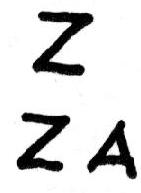
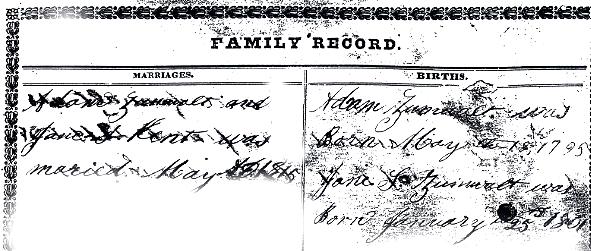
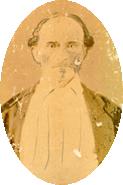 Andrew Alonzo (1 Sep 1817 MO-1 Nov 1886
TX)
Andrew Alonzo (1 Sep 1817 MO-1 Nov 1886
TX)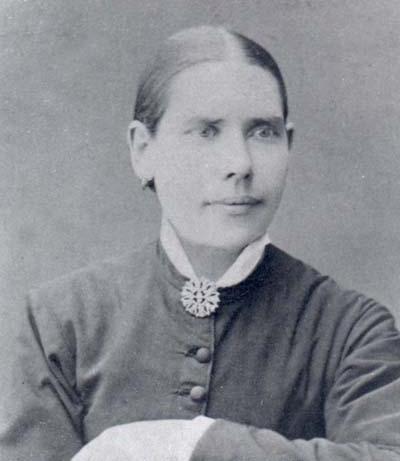 Thomas Bowen (9 Jan 1820 BooneCo, MO-Oct 1896 Capitan, NM)
Thomas Bowen (9 Jan 1820 BooneCo, MO-Oct 1896 Capitan, NM)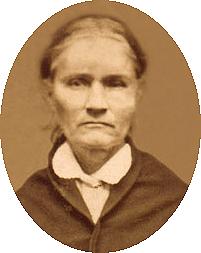
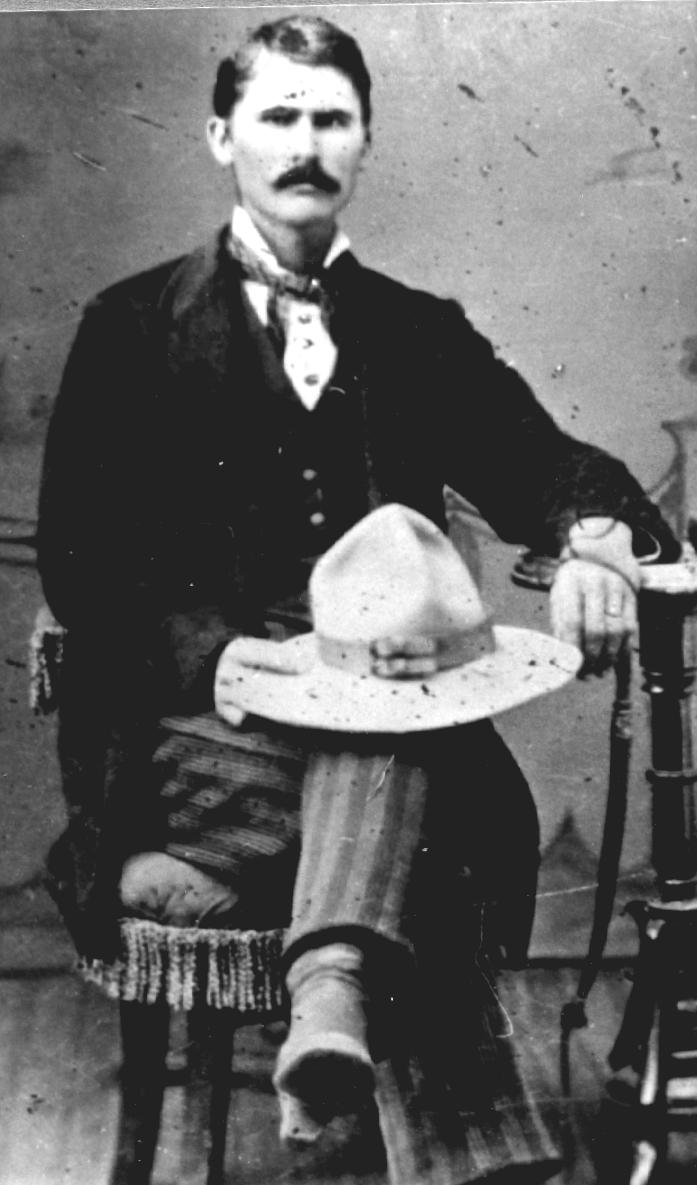 m. (2) Alan
Love (photo left) (abt 1800 VA-1853) 11 Oct 1848 Petersburg, LavacaCo,
TX. [According to some databases, this photo is actually of Thomas
Bowen Zumwalt, brother in law of Alan Love]
m. (2) Alan
Love (photo left) (abt 1800 VA-1853) 11 Oct 1848 Petersburg, LavacaCo,
TX. [According to some databases, this photo is actually of Thomas
Bowen Zumwalt, brother in law of Alan Love]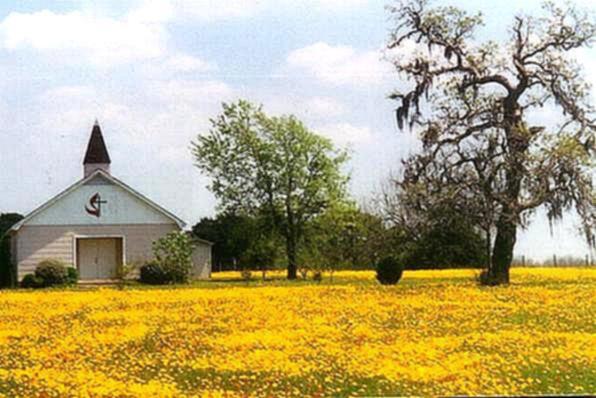


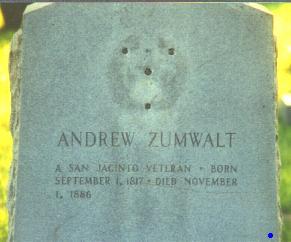
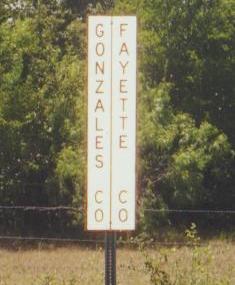
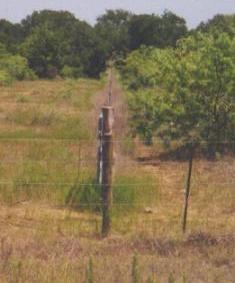
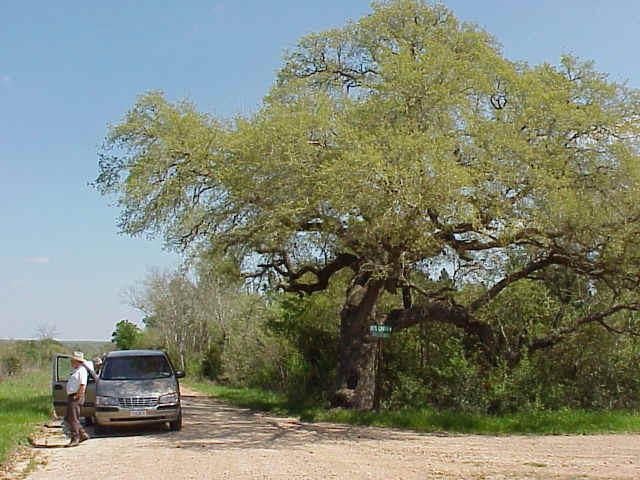 The community of Elm
Grove is currently marked by the presence of the Elm Grove Baptist Church and cemetery on
State Road 1115. As 1115 crosses into FayetteCo from GonzalesCo, it veers sharply
east at the county line (photos above) to Elm Grove Community. A county
road Double Live Oaks Lane, obviously named after the historic twin oak landmark,
continues northwest off 1115 at the county line. At the intersection of Double Live
Oaks Lane and Bar Ranch Road that runs north is believed to stand one of the historic twin
live oaks (photo left, courtesy of Gary McKee).
The community of Elm
Grove is currently marked by the presence of the Elm Grove Baptist Church and cemetery on
State Road 1115. As 1115 crosses into FayetteCo from GonzalesCo, it veers sharply
east at the county line (photos above) to Elm Grove Community. A county
road Double Live Oaks Lane, obviously named after the historic twin oak landmark,
continues northwest off 1115 at the county line. At the intersection of Double Live
Oaks Lane and Bar Ranch Road that runs north is believed to stand one of the historic twin
live oaks (photo left, courtesy of Gary McKee).